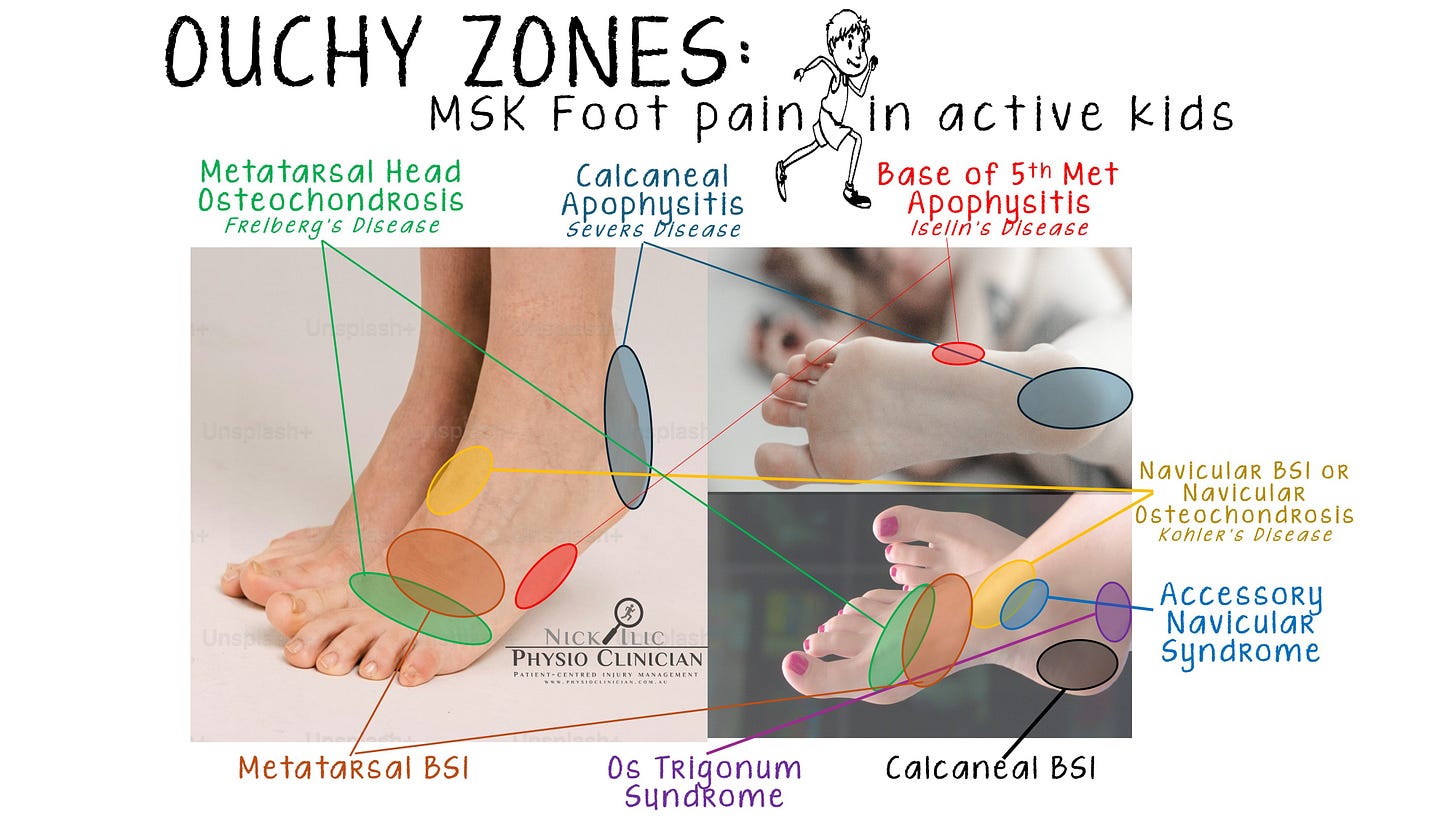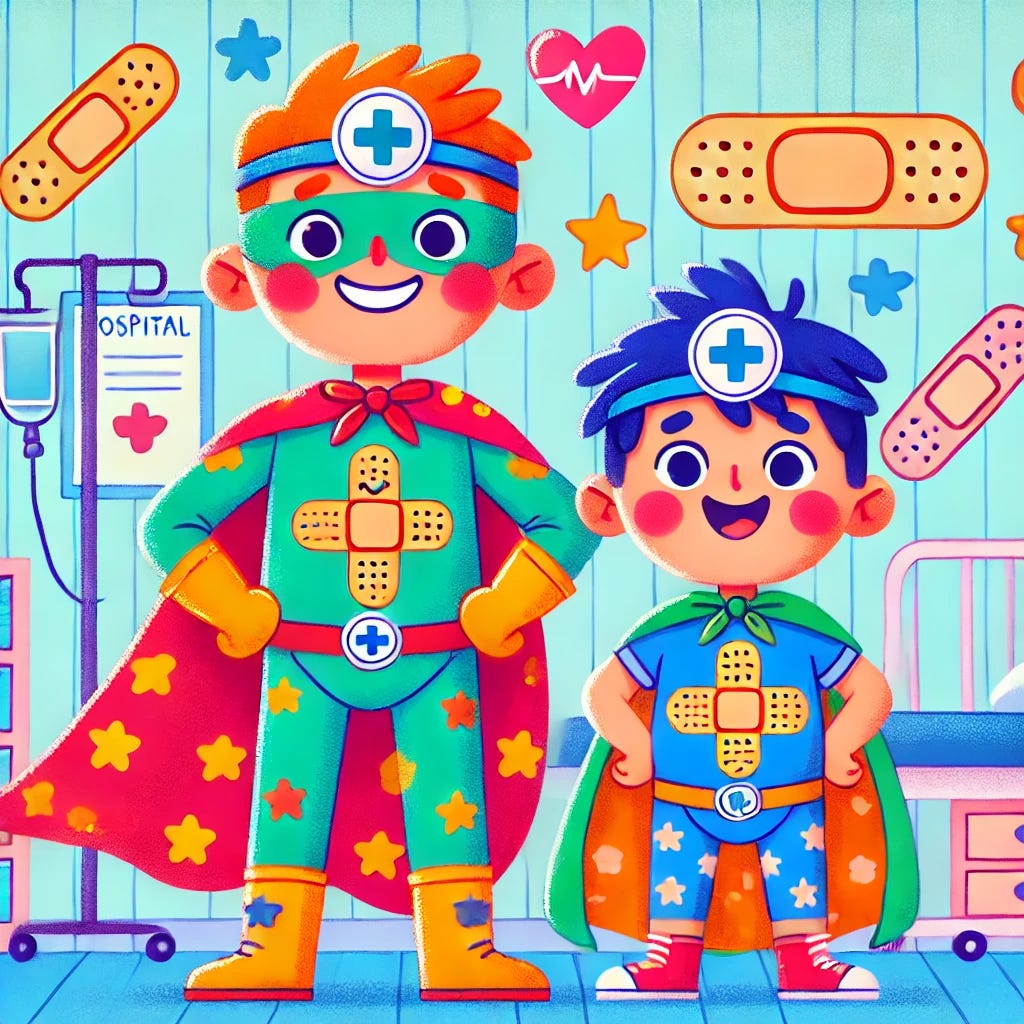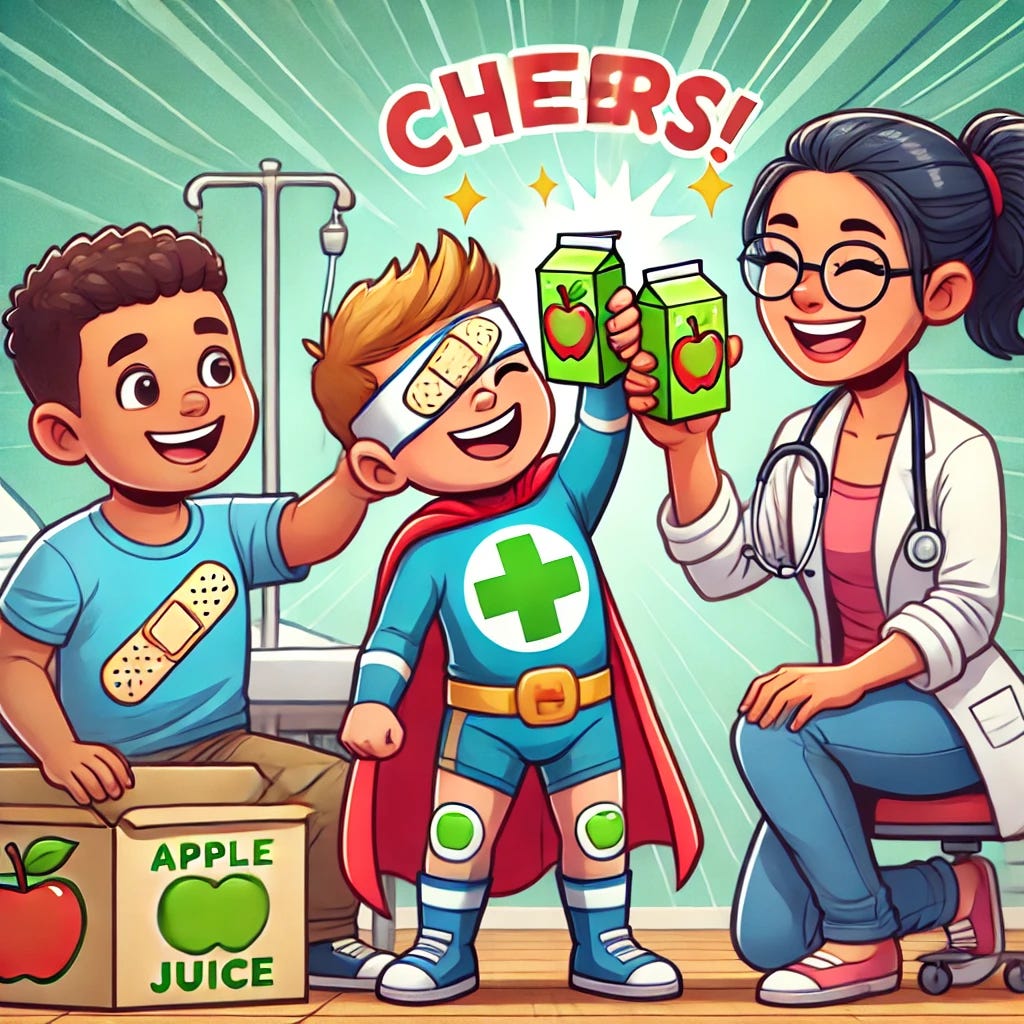Parents Playbook | My Kiddo Has an Ouchy Foot!
A Parent’s Guide to Common Foot Pains in Kids & Teens
This is a no-paywall blog post with insights I believe are valuable. If you find it useful, subscribe to my Substack for more in-depth content, exclusive case studies, and clinical insights.
Your support helps me continue sharing everything I’ve learned in the clinic with the world.
☕ Prefer a one-off thank you? Buy Me a Coffee.
This post is a guide only and should not be taken as medical advice. It does not replace assessment and recommendations from a registered and regulated healthcare professional.
You're familiar with the scene: your child comes home after sport, school, or playground adventures, and dramatically declares, “My foot hurts!” Cue parental panic.
Before you rush off to Google, convinced it's something rare and serious, let's take a breather. Most likely, when it comes to Musculoskeletal Conditions, it's a common, growth-related condition that's making their foot a bit too 'ouchy' for comfort.
First, Let's Bust a Myth...
40-year-old condition in a 10-year-old?! Seriously?!
Recently, I heard from a frustrated parent who was told by a certain healthcare provider that their 10-year-old had Morton’s Neuroma. Let’s just say, this provider clearly missed the day they covered foot conditions in class (or maybe they thought they'd discovered the youngest ever documented case).
Lesson Learned: Kids don't typically get adult-specific musculoskeletal issues—like Morton’s Neuroma, back pain, or rotator cuff injuries (which are practically unheard of until almost age 30).
Instead, children and adolescents have their own special collection of musculoskeletal problems, usually linked to overload at rapidly growing bones and growth plates. That's why it’s crucial to see a healthcare provider who specialises in paediatrics and adolescent conditions.

The Usual Suspects – Growing Pains and Overuse Injuries
Kids aren't just small adults—they have their own unique set of foot problems. Here’s a small sample what they can get that we (usually) have grown out of:
Sever's Disease (Calcaneal Apophysitis): Commonly affects kids aged 8–14 who play sports involving running and jumping, leading to pain at the back of the heel.
Iselin’s Disease (Apophysitis at the base of the 5th Metatarsal): Pain on the outer midfoot, common in athletic pre-teens involved in soccer, basketball, and gymnastics.
Kohler’s Disease (Navicular Osteochondrosis/Avascular Necrosis): Typically affects kids under 10, causing midfoot pain and limping.
Freiberg’s Disease (Metatarsal Head Osteochondrosis/Avascular Necrosis): Often seen in teenage girls active in dance or gymnastics, causing forefoot pain.
Accessory Navicular Syndrome: Causes pain on the inside of the midfoot, common among sporty teens.
Os Trigonum Syndrome: Pain at the back of the ankle during movements like toe pointing, common in teen dancers and soccer players.
and many more.
Bone Stress Injuries – The Sneaky Overachievers
Metatarsal Stress Fracture: Slow-building midfoot pain in active adolescents involved in running or basketball.
Navicular Stress Fracture: Persistent midfoot pain common in high-mileage runners and basketball players.
Calcaneal Stress Fracture: Heel pain worsened by impact, common among gymnasts and basketball players.
and many more.
What It's Probably NOT (Besides Morton’s Neuroma!)
Adult-Ouchies like nerve pain, bunions, or arthritis - these are highly unlikely if your child is under 15.
However, this must be screened by an experienced Healthcare Provider for funky stuff like early-onset Rheumatic Diseases and a few other nasties.
Okay, Great. Now What?
Congratulations!
I know… it’s weird right now to do this, but:
Pat yourself on the back!
You’re likely a parent who has encouraged your kids to be active, and exercise regularly. This is a super important time in their life where how active they are now, will pay off later (bone density, tendon capacity, cardiovascular and metabolic health benefits etc.).
This is usually a “too much of a good thing” problem, that’s a good problem to have. Well done you!
Don't panic! Most conditions respond well to rest and a gradual return to activity/sport/exercise, appropriate footwear, and guidance from physios or podiatrists.
Footwear Matters: Good, supportive shoes can be the best friends your kid’s feet never knew they needed.
GET CHECKED: Consult a Musculoskeletal Physiotherapist, Podiatrist, Sports Doctor or Sports and Exercise Medicine Physician, or a GP, experienced in paediatric and adolescent sports injuries.
There might be unique management to different conditions, and different investigations required - please see someone for assessment. (If you can’t find anyone, get in touch, I’m always happy to help you find someone in your part of the world).
Final Takeaway
Growing pains are real but manageable! Your child's "ouchy" foot is often a sign they're growing, playing, and living actively. Stay calm, dial things back until the ouchy goes, and try to gradually return them and see if the ouchy comes back.
But please please please please (…. and please): get your kiddo checked if pain persists > 2 weeks, and here's to fewer 'ouchies' and more smiles!
Want More Info?
Check out these other Parents Playbook guides:
Did this help you understand your child’s pain better or make a more informed decision? If so, even a small contribution helps me keep content like this going.
This is high-value clinical insight that often costs hundreds of dollars in a clinic—but here, it’s freely shared for the sake of better care for kids everywhere.
Why would I do that? Because I’m a dad too. I want the best for my kids, and I care about their wellbeing more than my own (ask my wife!). That’s why I treat my patients’ kids like they’re my own—and that includes doing everything I can to spread quality, no-nonsense healthcare information.
☕ Buy Me a Coffee to say thanks, or become a paid subscriber—you’ll get access to more expert insights and can ask me questions about your pain anytime!
Tailor your Nick Ilic | Physio Clinician subscription:
You can customise which topics you receive updates for by selecting 'Manage Subscription' in your Substack options (in your browser), or by clicking 'unsubscribe' at the bottom of any email—don’t worry, it won’t unsubscribe you immediately! You'll then be able to choose your preferred sections:
✅ Patient Playbook
✅ Clinician’s Corner
✅ Research Reviews
✅ Clinician’s Compass
Choose what suits you best—I promise I won’t take it personally!













